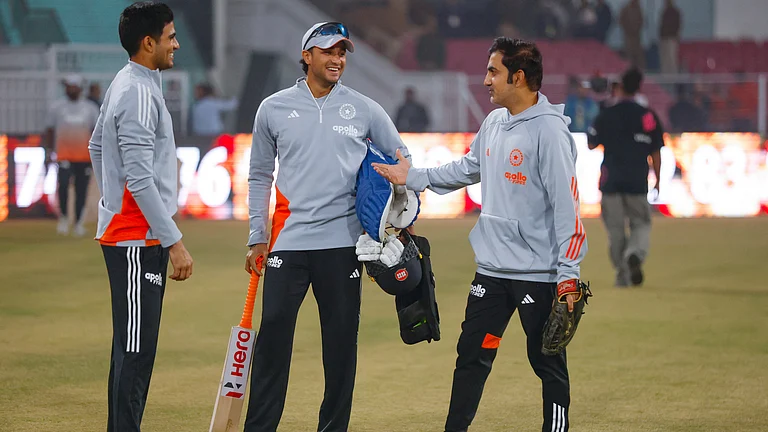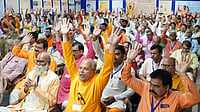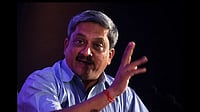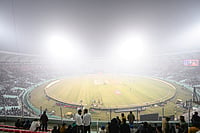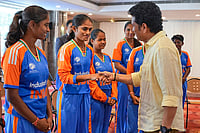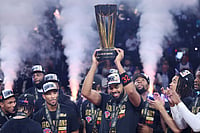It was a woman who took to the skies on December 19, 1961 and announced to hundreds and thousands of Goans that the sun had actually set on the 451-year-old Portuguese colonial regime. Libia Lobo, who was in her early 30s at the time, used to run an underground political radio station Voz de Liberdade (Voice of Liberation) from the forests bordering Portuguese-held Goa and the Indian states of Maharashtra and Karnataka. At the insistence of Lt. General J.N. Chaudhari, Lobo boarded an Indian Air Force plane to broadcast the news of the liberation of Goa by the Indian armed forces to the now-former Portuguese colony.
Circa 2022, the status of women in political life in Goa appears to have plummeted far from the heights that Lobo had soared to in 1961. The 2017 assembly elections saw just two women MLAs elected to office, Congress’ Jennifer Monseratte from Taleigao and BJP’s Alina Saldanha from Cortalim. Both were sitting MLAs. Jennifer, a housewife, is the spouse of local political strongman Atanasio Monserrate, while Saldanha, a teacher, was first elected to the state assembly in 2012, months after her husband Mathany Saldanha, who was a cabinet minister in a BJP-led coalition government, died in office that year.
The spousal ladder in politics isn’t a rare phenomenon across India. But what makes the relative absence of women in politics a case for scrutiny in Goa is the state’s progressive image and healthy score when it comes to social indices, in comparison to several other Indian states. Women’s literacy rate in Goa, for example, stands at 84.66 per cent compared to the national average of 74.04 per cent, according to the 2011 general census. “Goa is believed to be economically and socially progressive on many parameters, yet when it comes to women’s representation, it does not show much progress. This reveals that gender discrimination very much exists and is influential in our society,” argues Prachi Prabhu, an assistant professor of Women’s Studies at Goa University. “When it comes to leadership positions, we see a negligible number of women. The selection of women candidates is often considered on the basis of which family they belong to, so their identity as daughters, daughters-in-law, sisters or wives, comes to the forefront. Women political leaders who come without a political family (to rely on) are also judged on the basis of whether they affirm the given gender norms,” Prabhu adds.

Former power minister and a two-time state Congress president Sawant makes a case for two Goas, as she tries to explain the anomaly of why a state, perceived as a liberal partying ground for the country, has thrown up very few women lawmakers. The epidermal Goa which visitors get to see, where men and women party together, hit bars and pubs together without raising eyebrows and the length of a skirt matters less, is far different from the Goa which lies just beneath the surface. Sawant suggests that not too far from the state’s cosmopolitan sands and the dance floors of popular clubs, the far too familiar regressive beasts of patriarchy and conservatism continue to haunt women and rein them back. “It is a liberal state for those who are enjoying life, those who visit Goa, head out for picnics, drink alcohol. For that section of the society, Goa is liberal,” according to Sawant.
Nirmala Sawant was one of the few women legislators who made it to the upper rungs of politics on her own and without the spousal ladder. She credits her brother—her father died from a Portuguese bullet in the freedom struggle—for providing her the conducive environment to pursue politics. But there were limitations. The compulsion of taking the last bus at 7 pm from Panaji to her home was one. The bus ride home was Sawant’s ‘sundowner’ in the 1960s. According to her, the inability of a woman to sit in a bar and ‘bond’ with her male political colleagues was a political hamstring which could make a critical difference in the fine margins of a campaign and voter count. “When you are in the election campaign, men can sit in bars with other groups, women cannot. So creating that closeness, that bonding is difficult. That is very important. That drink in a bar with that group (of political supporters) makes a lot of difference. I have lost elections by around 500 votes, this could have been the reason,” she says.

Bars and taverns in Goa continue to be the watering holes for political bonding, especially in semi-urban and rural landscapes and are frequented by politicians and their cliques to gently gauge the subaltern pulse over a few drinks. Sanjiv Verenkar, a noted poet and former journalist, also says that the increasing significance of money in politics, especially during elections, had driven women to the fringes. “Men still find it difficult to speak money, a critical component in electioneering, with women and perhaps it’s vice-versa too,” Verenkar says.
The freedom movement in Goa, which picked up steam after India’s independence, saw women plunge themselves headlong into the resistance movement. Seema Salgaonkar, in her 2000 thesis ‘Women political power and the state in Goa’, says that several leading women freedom fighters—Shalini Phaldesai, Sharada Savaikar, Mogabai Naik and Prema N. Tendulkar—were “influenced by their brothers who were (already) involved in the liberation struggle” or other familiar men involved in the movement.
There were other—but all too rare—sources of inspiration too, like Sindhutai Deshpande, a Maharashtrian, who participated in the Quit India movement. Deshpande toured extensively in Goa, encouraging women in the Portuguese-held colony to participate in the movement. But after Liberation, the same women who actively contributed to the movement found themselves back in the confines of patriarchy, in order to re-adapt to their expected, conformist roles as “sisters, mothers or wives”.

“In fact, most of the women freedom fighters entered the struggle due to family influence, where their brothers, father or husband were involved in the movement. Once the struggle was over, the women freedom fighters were sent back to their traditional roles. Now the situation was ‘normal’ and hence the men in their family were capable in deciding what was best suited for the women in their family, and therefore there was no need for them to enter public arenas!” Salgaonkar says in her thesis.
The patriarchal pullback can be gauged from the fact that in the first assembly polls held in Goa in 1963, only one woman, Urminda Leitao, was elected to the assembly, from the Mormugao assembly constituency. Two women were elected to the subsequent assembly in 1967, while one woman each was elected to the next two state assemblies.
After the 1980 assembly polls resulted in zero women being represented in Goa’s unicameral legislature, in 1984, chief minister Pratapsingh Rane nominated three women—Sangeeta Parab, Phyllis Faria and Sulochana Katkar—to the legislature through a presidential directive. Goa was still a Union Territory then and nominated members could attend assembly sessions, but were not entitled to vote on legislative motions and bills.
The only bright spark as far as women’s representation in the state legislature was in 1994 when four women—Sangeeta Parab, Victoria Fernandes, Fatima D’Sa and Shashikala Kakodkar—were elected to the assembly. Kakodkar was the daughter of the state’s first chief minister Dayanand Bandodkar and had also served as chief minister twice between 1973-1979. Barring Kakodkar, whose career stemmed from political lineage, Parab, Fernandes and D’Sa had made it on their own in politics. The late Victoria Fernandes, also known as ‘Mummy’, had actively participated in the Opinion poll movement, canvassing for retention of Goa as an independent territory in the Indian Union. She became a relatively permanent fixture in state politics for two decades, the latter half of which was aided by the nativist mob ‘Goa Protectors’ led by her son Rudolf.
By the mid-to-late 1990s, liberalisation had phased out the era of smuggling in Goa and real estate deals had begun adding financial heft to political muscle in the state, something which the Fernandes mother-son duo exploited well in the name of saving Goa from being sold to outsiders. “Women would have baulked at such a model and never would have entertained a thought about a political career. But it may have given rise to the likes of Victoria Fernandes. By this time the lumpen element was a strong force in politics,” says author and historian Dr. Savia Viegas.
It is not that the political significance of women as a votebank has been lost on political parties in Goa. Women voters have been aggressively pursued by political parties, like the Trinamool Congress and Aam Aadmi Party, which have announced women-centric financial doles. But their representation in the electoral contests continues to be linked to the political clout of their spouses. In the just-held elections, five couples are in the fray. A father-daughter duo—former chief minister Churchill Alemao and Valanka—are also in the fray, fielded by the Trinamool Congress.
According to Tricia Vaz e Borges, an associate professor of political science at Goa’s St. Xavier’s College, while very few women are willing to participate and take up political positions because of family responsibilities, those who do face hurdles in party organisations. “Lack of confidence in women leaders by political parties is a big issue. Political parties look at factors like winnability and are not willing to take the risk of nominating women candidates,” she says. Women politicians like Fatima D’Sa, a former transport minister, had to feel the brunt of her own chief minister’s ire in the 1990s for speaking her mind in the state assembly. “When I was in the assembly, I used to question my own government. And the then chief minister told me, ‘with you in the assembly, we do not require an opposition’. Because, certain things which I did not like I used to question the government despite being on the ruling side. That was not liked at all,” D’Sa says.
So, is there a way for women in Goa to break the glass ceiling? There are two divergent views. Former Goa State Women’s Commission chairperson Dr. Pramod Salgaocar argues that reservation of seats for women in legislatures could be the way, but according to Sawant, the change has to come through scientific education and breaking the shackles of religion and social demands in a woman’s role. “How many hours does a woman have to spend in religious customs and traditions? Religion has made women helpless. Women have to decide what they want to do. Women should be educated in the correct way, scientific way, only then can change be brought,” she adds.
(This appeared in the print edition as "She by the Seashore")
(Views expressed are personal)
ALSO READ
Mayabhushan Nagvenkar is the Goa correspondent for Indo-Asian News Service







